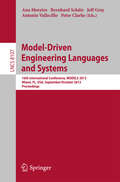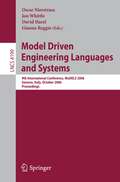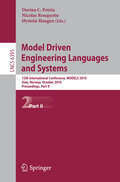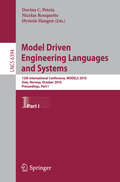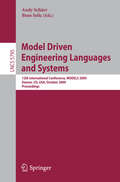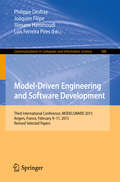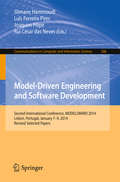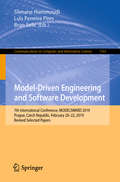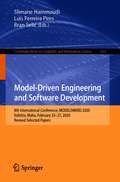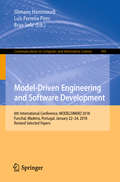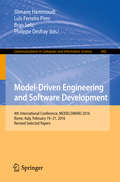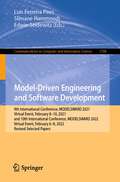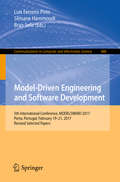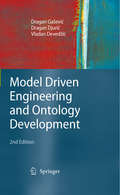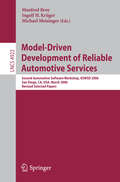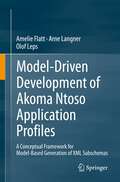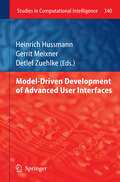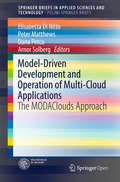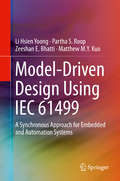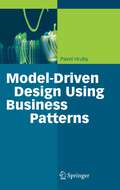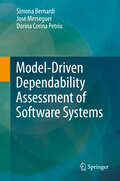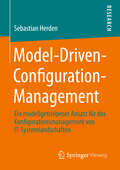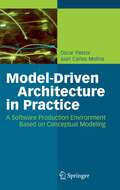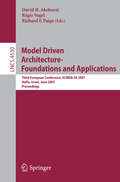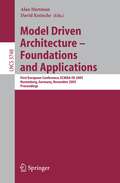- Table View
- List View
Model-Driven Engineering Languages and Systems: 16th International Conference, MODELS 2013, Miami, FL, USA, September 29 – October 4, 2013. Proceedings (Lecture Notes in Computer Science #8107)
by Ana Moreira Bernhard Schätz Jeff Gray Antonio Vallecillo Peter ClarkeThis book constitutes the refereed proceedings of the 16th International Conference on Model Driven Engineering Languages and Systems, MODELS 2013, held in Miami, FL, USA, in September/October 2013. The 47 full papers presented in this volume were carefully reviewed and selected from a total of 180 submissions. They are organized in topical sections named: tool support; dependability; comprehensibility; testing; evolution; verification; product lines; semantics; domain-specific modeling languages; models@RT; design and architecture; model transformation; model analysis; and system synthesis.
Model Driven Engineering Languages and Systems: 9th International Conference, MoDELS 2006, Genova, Italy, October 1-6, 2006, Proceedings (Lecture Notes in Computer Science #4199)
by Oscar Nierstrasz Jon Whittle David Harel Gianna ReggioThis book constitutes the refereed proceedings of the 9th International Conference on Model Driven Engineering Languages and Systems (formerly UML conferences), MoDELS 2006. The book presents 51 revised full papers and 2 invited papers. Discussion is organized in topical sections on evaluating UML, MDA in software development, concrete syntax, applying UML to interaction and coordination, aspects, model integration, formal semantics of UML, security, model transformation tools and implementation, and more.
Model Driven Engineering Languages and Systems: 13th International Conference, MODELS 2010, Oslo, Norway 3-8, 2010, Proceedings, Part II (Lecture Notes in Computer Science #6395)
by Dorina C. Petriu Nicolas Rouquette Oystein HaugenThe MODELS series of conferences is the premier venue for the exchange of - novative technical ideas and experiences focusing on a very important new te- nical discipline: model-driven software and systems engineering. The expansion ofthisdisciplineisadirectconsequenceoftheincreasingsigni?canceandsuccess of model-based methods in practice. Numerous e?orts resulted in the invention of concepts, languagesand tools for the de?nition, analysis,transformation, and veri?cationofdomain-speci?cmodelinglanguagesandgeneral-purposemodeling language standards, as well as their use for software and systems engineering. MODELS 2010, the 13th edition of the conference series, took place in Oslo, Norway, October 3-8, 2010, along with numerous satellite workshops, symposia and tutorials. The conference was fortunate to have three prominent keynote speakers: Ole Lehrmann Madsen (Aarhus University, Denmark), Edward A. Lee (UC Berkeley, USA) and Pamela Zave (AT&T Laboratories, USA). To provide a broader forum for reporting on scienti?c progress as well as on experience stemming from practical applications of model-based methods, the 2010 conference accepted submissions in two distinct tracks: Foundations and Applications. The primary objective of the ?rst track is to present new research results dedicated to advancing the state-of-the-art of the discipline, whereas the second aims to provide a realistic and veri?able picture of the current state-- the-practice of model-based engineering, so that the broader community could be better informed of the capabilities and successes of this relatively young discipline. This volume contains the ?nal version of the papers accepted for presentation at the conference from both tracks.
Model Driven Engineering Languages and Systems: 13th International Conference, MODELS 2010, Oslo, Norway, October 3-8, 2010, Proceedings, Part I (Lecture Notes in Computer Science #6394)
by Dorina C. Petriu Nicolas Rouquette Oystein HaugenThe MODELS series of conferences is the premier venue for the exchange of - novative technical ideas and experiences focusing on a very important new te- nical discipline: model-driven software and systems engineering. The expansion ofthisdisciplineisadirectconsequenceoftheincreasingsigni?canceandsuccess of model-based methods in practice. Numerous e?orts resulted in the invention of concepts, languagesand tools for the de?nition, analysis,transformation, and veri?cationofdomain-speci?cmodelinglanguagesandgeneral-purposemodeling language standards, as well as their use for software and systems engineering. MODELS 2010, the 13th edition of the conference series, took place in Oslo, Norway, October 3-8, 2010, along with numerous satellite workshops, symposia and tutorials. The conference was fortunate to have three prominent keynote speakers: Ole Lehrmann Madsen (Aarhus University, Denmark), Edward A. Lee (UC Berkeley, USA) and Pamela Zave (AT&T Laboratories, USA). To provide a broader forum for reporting on scienti?c progress as well as on experience stemming from practical applications of model-based methods, the 2010 conference accepted submissions in two distinct tracks: Foundations and Applications. The primary objective of the ?rst track is to present new research results dedicated to advancing the state-of-the-art of the discipline, whereas the second aims to provide a realistic and veri?able picture of the current state-- the-practice of model-based engineering, so that the broader community could be better informed of the capabilities and successes of this relatively young discipline. This volume contains the ?nal version of the papers accepted for presentation at the conference from both tracks.
Model Driven Engineering Languages and Systems: 12th International Conference, MODELS 2009, Denver, CO, USA, October 4-9, 2009, Proceedings (Lecture Notes in Computer Science #5795)
by Andy Schürr Bran V. SelicThe pioneering organizers of the ?rst UML workshop in Mulhouse, France inthe summerof1998couldhardlyhaveanticipatedthat,in littleoveradecade, theirinitiativewouldblossomintotoday’shighlysuccessfulMODELSconference series, the premier annual gathering of researchersand practitioners focusing on a very important new technical discipline: model-based software and system engineering. This expansion is, of course, a direct consequence of the growing signi?cance and success of model-based methods in practice. The conferences have contributed greatly to the heightened interest in the ?eld, attracting much young talent and leading to the gradualemergence of its correspondingscienti?c and engineering foundations. The proceedings from the MODELS conferences are one of the primary references for anyone interested in a more substantive study of the domain. The 12th conference took place in Denver in the USA, October 4–9, 2009 along with numerous satellite workshops and tutorials, as well as several other related scienti?c gatherings. The conference was exceptionally fortunate to have three eminent, invited keynote speakers from industry: Stephen Mellor, Larry Constantine, and Grady Booch.
Model-Driven Engineering and Software Development: Third International Conference, MODELSWARD 2015, Angers, France, February 9-11, 2015, Revised Selected Papers (Communications in Computer and Information Science #580)
by Philippe Desfray Joaquim Filipe Slimane Hammoudi Luís Ferreira PiresThis book constitutes thoroughly revised and selected papers from the Third International Conference on Model-Driven Engineering and Software Development, MODELSWARD 2015, held in Angers, France, in February 2015.The 25 thoroughly revised and extended papers presented in this volume were carefully reviewed and selected from 94 submissions. They are organized in topical sections named: invited papers; modeling languages, tools and architectures; methodologies, processes and platforms; applications and software development.
Model-Driven Engineering and Software Development: Second International Conference, MODELSWARD 2014, Lisbon, Portugal, January 7-9, 2014, Revised Selected Papers (Communications in Computer and Information Science #506)
by Slimane Hammoudi Luís Ferreira Pires Joaquim Filipe Rui César das NevesThis book constitutes thoroughly revised and selected papers from the Second International Conference on Model-Driven Engineering and Software Development, MODELSWARD 2014, held in Lisbon, Portugal, in January 2014. The 10 thoroughly revised and extended papers presented in this volume were carefully reviewed and selected from 88 submissions. They are organized in topical sections named: invited papers; modeling languages, tools and architectures; and methodologies, processes and platforms.
Model-Driven Engineering and Software Development: 7th International Conference, MODELSWARD 2019, Prague, Czech Republic, February 20–22, 2019, Revised Selected Papers (Communications in Computer and Information Science #1161)
by Slimane Hammoudi Luís Ferreira Pires Bran SelićThis book constitutes thoroughly revised and selected papers from the 7th International Conference on Model-Driven Engineering and Software Development, MODELSWARD 2019, held in Prague, Czech Republic, in February 2019.The 16 thoroughly revised and extended papers presented in this volume were carefully reviewed and selected from 76 submissions. They address some of the most relevant challenges being faced by researchers and practitioners in the field of model-driven engineering and software development and cover topics like language design and tooling; programming support tools; code and text generation from models, behavior modeling and analysis; model transformations and multi-view modeling; as well as applications of MDD and its related techniques to cyber-physical systems, cyber security, IoT, autonomous vehicles and healthcare.
Model-Driven Engineering and Software Development: 8th International Conference, MODELSWARD 2020, Valletta, Malta, February 25–27, 2020, Revised Selected Papers (Communications in Computer and Information Science #1361)
by Slimane Hammoudi Luís Ferreira Pires Bran SelićThis book constitutes thoroughly revised and selected papers from the 8th International Conference on Model-Driven Engineering and Software Development, MODELSWARD 2020, held in Valletta, Malta, in February 2020. The 15 revised and extended papers presented in this volume were carefully reviewed and selected from 66 submissions. They present recent research results and development activities in using models and model driven engineering techniques for software development. The papers are organized in topical sections on methodologies, processes and platforms; applications and software development; modeling languages, tools and architectures.
Model-Driven Engineering and Software Development: 6th International Conference, MODELSWARD 2018, Funchal, Madeira, Portugal, January 22-24, 2018, Revised Selected Papers (Communications in Computer and Information Science #991)
by Slimane Hammoudi Luís Ferreira Pires Bran SelicThis book constitutes thoroughly revised and selected papers from the 6th International Conference on Model-Driven Engineering and Software Development, MODELSWARD 2018, held in Funchal, Madeira, Portugal, in January 2018. The 22 thoroughly revised and extended papers presented in this volume were carefully reviewed and selected from 101 submissions. They contribute to the development of highly relevant research trends in model-driven engineering and software development such as innovative methods for MDD-based development and testing of web-based applications and user interfaces, support for development of Domain-Specific Languages (DSLs), MDD-based application development on multiprocessor platforms, advances in MDD tooling, formal semantics and behaviour modelling, and MDD-based product-line engineering.
Model-Driven Engineering and Software Development: 4th International Conference, MODELSWARD 2016, Rome, Italy, February 19-21, 2016, Revised Selected Papers (Communications in Computer and Information Science #692)
by Slimane Hammoudi Luís Ferreira Pires Bran Selic Philippe DesfrayThis book constitutes thoroughly revised and selected papers from the 4th International Conference on Model-Driven Engineering and Software Development, MODELSWARD 2016, held in Rome, Italy, in February 2016.The 17 thoroughly revised and extended papers presented in this volume were carefully reviewed and selected from 118 submissions. They are organized in topical sections named: modeling languages, tools and architectures; methodologies, processes and platforms; applications and software development.
Model-Driven Engineering and Software Development: 9th International Conference, MODELSWARD 2021, Virtual Event, February 8–10, 2021, and 10th International Conference, MODELSWARD 2022, Virtual Event, February 6–8, 2022, Revised Selected Papers (Communications in Computer and Information Science #1708)
by Luís Ferreira Pires Slimane Hammoudi Edwin SeidewitzThis book constitutes the refereed post-proceedings of the 9th International Conference and 10th International Conference on Model-Driven Engineering and Software Development, MODELSWARD 2021 and MODELSWARD 2022, was held virtually due to the COVID-19 crisis on February 8–10, 2021 and February 6–8, 2022.The 11 full papers included in this book were carefully reviewed and selected from 121 submissions. The purpose of the International Conference on model-driven engineering and software development is to provide a platform for researchers, engineers, academics as well as industrial professionals from all over the world to present their research results and development activities in using models and model driven engineering techniques for system development.
Model-Driven Engineering and Software Development: 5th International Conference, MODELSWARD 2017, Porto, Portugal, February 19-21, 2017, Revised Selected Papers (Communications in Computer and Information Science #880)
by Luís Ferreira Pires Slimane Hammoudi Bran SelicThis book constitutes thoroughly revised and selected papers from the 5th International Conference on Model-Driven Engineering and Software Development, MODELSWARD 2017, held in Porto, Portugal, in February 2017. The 20 thoroughly revised and extended papers presented in this volume were carefully reviewed and selected from 91 submissions. They contribute to the development of highly relevant research trends in model-driven engineering and software development such as methodologies for MDD development and exploitation, model-based testing, model simulation, domain-specific modeling, code generation from models, new MDD tools, multi-model management, model evolution, and industrial applications of model-based methods and technologies.
Model Driven Engineering and Ontology Development
by Dragan Gaševic Dragan Djuric Vladan DevedžicDefining a formal domain ontology is considered a useful, not to say necessary step in almost every software project. This is because software deals with ideas rather than with self-evident physical artefacts. However, this development step is hardly ever done, as ontologies rely on well-defined and semantically powerful AI concepts such as description logics or rule-based systems, and most software engineers are unfamiliar with these. This book fills this gap by covering the subject of MDA application for ontology development on the Semantic Web. The writing is technical yet clear, and is illustrated with examples. The book is supported by a website.
Model-Driven Development of Reliable Automotive Services: Second Automotive Software Workshop, ASWSD 2006, San Diego, CA, USA, March 15-17, 2006, Revised Selected Papers (Lecture Notes in Computer Science #4922)
by Manfred Broy Ingolf Krüger Michael MeisingerSoftware development for the automotive domain has become the enabling te- nologyforalmostallsafety-criticalandcomfortfunctionso?eredtothecustomer. Ninety percentofallinnovations inautomotive systems aredirectly or indirectly enabled by embedded software. The numbers of serious accidents have declined in recent years, despite constantly increasing tra?c; this is correlated with the introduction of advanced, software-enabled functionality for driver assistance, such as electronic stability control. Software contributes signi?cantly to the - tomotive value chain. By 2010 it is estimated that software will make up 40% of the value creation of automotive electrics/electronics. However, with the large number of software-enabled functions, their int- actions, and the corresponding networking and operating infrastructure, come signi?cant complexities both during the automotive systems engineering p- cess and at runtime. A central challenge for automotive systems development is the scattering of functionality across multiple subsystems, such as electronic control units (ECUs) and the associated networks. As an example, consider the central locking systems (CLS), whose functionality is spread out over up to 19 di?erent ECUs in some luxury cars. Of course, this includes advanced functi- ality, such as seat positioning and radio tuning according to driver presets upon entry, as well as unlocking in case of a detected impact or accident. However, thisexampledemonstratesthatmodernautomotivesystemsbridgecomfort-and safety-critical functionality. This induces particular demands on safety and - curity, and, in general, software and systems quality. The resulting challenges and opportunities were discussed, in depth, at the second Automotive Software Workshop San Diego (ASWSD) 2006, on whose results we report here.
Model-Driven Development of Akoma Ntoso Application Profiles: A Conceptual Framework for Model-Based Generation of XML Subschemas
by Amelie Flatt Arne Langner Olof LepsThis book presents a model-driven approach for creating a national application profile of the international legislative document standard Akoma Ntoso (AKN). AKN is an XML-based document standard that serves as the basis for modern machine-readable and fully digital legislative and judicial processes. The described model-driven development approach ensures consistent and error-proof application of AKN concepts and types, even when using different software tools. It allows for easy maintenance, is self-documenting, and facilitates stakeholder validation with nontechnical legal experts. The resulting application profile remains fully compliant to and compatible with AKN. For the sake of illustration, the approach is paradigmatically applied to the German federal legislative process, as a corresponding approach was used in the creation of the German AKN application profile, LegalDocML.de. We discuss how the methodology yields a model, schema definition and specification that correspond to the artefacts created by LegalDocML.de, using examples from Germany. The book is of interest to both legal and technical project teams on the cusp of introducing AKN in a legislative domain and intended as a practical guideline for teams preparing to create a custom application profile for their own domain. Furthermore, it can serve as both a resource and an inspiration for similar and yet to be developed methodologies in the public sector, the health sector or in defense, where international standardization and interoperability efforts are to be applied to a local level.
Model-Driven Development of Advanced User Interfaces (Studies in Computational Intelligence #340)
by Heinrich Hussmann Gerrit Meixner Detlef ZuehlkeModel-Driven Development (MDD) has become an important paradigm in software development. It uses models as primary artifacts in the development process. This book provides an outstanding overview as well as deep insights into the area of model-driven development of user interfaces, which is an emerging topic in the intersection of Human-Computer-Interaction and Software-Engineering. The idea of this book is based on the very successful workshop series of “Model-Driven Development of Advanced User Interfaces (MDDAUI)”. It has been written by the leading researchers and practitioners in the field of model-driven development of user interfaces and offer a variety of solutions and examples for • Architectures and environments for the generation of user interfaces • User interface development for specific domains and purposes • Model-driven development in the context of ambient intelligence • Concepts supporting model-driven development of user interfaces
Model-Driven Development and Operation of Multi-Cloud Applications: The MODAClouds Approach (SpringerBriefs in Applied Sciences and Technology)
by Elisabetta Di Nitto Peter Matthews Dana Petcu Arnor SolbergThis books is open access under a CC BY 4.0 license.This book summarizes work being undertaken within the collaborative MODAClouds research project, which aims to facilitate interoperability between heterogeneous Cloud platforms and remove the constraints of deployment, portability, and reversibility for end users of Cloud services. Experts involved in the project provide a clear overview of the MODAClouds approach and explain how it operates in a variety of applications.While the wide spectrum of available Clouds constitutes a vibrant technical environment, many early-stage issues pose specific challenges from a software engineering perspective. MODAClouds will provide methods, a decision support system, and an open source IDE and run-time environment for the high-level design, early prototyping, semiautomatic code generation, and automatic deployment of applications on multiple Clouds. It will free developers from the need to commit to a fixed Cloud technology stack during software design and offer benefits in terms of cost savings, portability of applications and data between Clouds, reversibility (moving applications and data from Cloud to non-Cloud environments), risk management, quality assurance, and flexibility in the development process.
Model-Driven Design Using IEC 61499: A Synchronous Approach for Embedded and Automation Systems
by Li Hsien Yoong Partha S. Roop Zeeshan E. Bhatti Matthew M. KuoThis book describes a novel approach for the design of embedded systems and industrial automation systems, using a unified model-driven approach that is applicable in both domains. The authors illustrate their methodology, using the IEC 61499 standard as the main vehicle for specification, verification, static timing analysis and automated code synthesis. The well-known synchronous approach is used as the main vehicle for defining an unambiguous semantics that ensures determinism and deadlock freedom. The proposed approach also ensures very efficient implementations either on small-scale embedded devices or on industry-scale programmable automation controllers (PACs). It can be used for both centralized and distributed implementations. Significantly, the proposed approach can be used without the need for any run-time support. This approach, for the first time, blurs the gap between embedded systems and automation systems and can be applied in wide-ranging applications in automotive, robotics, and industrial control systems. Several realistic examples are used to demonstrate for readers how the methodology can enable them to reduce the time-to-market, while improving the design quality and productivity.
Model-Driven Design Using Business Patterns
by Pavel HrubyThis book shows how to apply pattern ideas in business applications. It presents more than 20 structural and behavioral business patterns that use the REA (resources, events, agents) pattern as a common backbone. The developer working on business frameworks can use the patterns to derive the right abstractions and to design and ensure that the meta-rules are followed by the developers of the actual applications. The application developer can use these patterns to design a business application, to ensure that it does not violate the domain rules, and to adapt the application to changing requirements without the need to change the overall architecture.
Model-Driven Dependability Assessment of Software Systems
by Simona Bernardi José Merseguer Dorina Corina PetriuOver the last two decades, a major challenge for researchers working on modeling and evaluation of computer-based systems has been the assessment of system Non Functional Properties (NFP) such as performance, scalability, dependability and security.In this book, the authors present cutting-edge model-driven techniques for modeling and analysis of software dependability. Most of them are based on the use of UML as software specification language. From the software system specification point of view, such techniques exploit the standard extension mechanisms of UML (i.e., UML profiling). UML profiles enable software engineers to add non-functional properties to the software model, in addition to the functional ones. The authors detail the state of the art on UML profile proposals for dependability specification and rigorously describe the trade-off they accomplish. The focus is mainly on RAMS (reliability, availability, maintainability and safety) properties. Among the existing profiles, they emphasize the DAM (Dependability Analysis and Modeling) profile, which attempts to unify, under a common umbrella, the previous UML profiles from literature, providing capabilities for dependability specification and analysis. In addition, they describe two prominent model-to-model transformation techniques, which support the generation of the analysis model and allow for further assessment of different RAMS properties. Case studies from different domains are also presented, in order to provide practitioners with examples of how to apply the aforementioned techniques.Researchers and students will learn basic dependability concepts and how to model them using UML and its extensions. They will also gain insights into dependability analysis techniques through the use of appropriate modeling formalisms as well as of model-to-model transformation techniques for deriving dependability analysis models from UML specifications. Moreover, software practitioners will find a unified framework for the specification of dependability requirements and properties of UML, and will benefit from the detailed case studies.
Model-Driven-Configuration-Management: Ein modellgetriebener Ansatz für das Konfigurationsmanagement von IT-Systemlandschaften
by Sebastian HerdenSebastian Herden präsentiert das Konzept des Model-Driven-Configuration-Managements (MDCM) zur Schließung der identifizierten semantischen Lücke zwischen Unternehmensarchitektur und IT-Konfiguration. Die grundlegende Idee des vorgestellten MDCM-Konzepts zur nahtlosen Integration von Enterprise-Architecture-Management und IT-Konfigurationsmanagement im IT-Betrieb ist es, einen Model-Driven-Engineering-Ansatz zu entwickeln. Das Ziel des MDCM ist neben der Ausrichtung der resultierenden IT-Konfiguration an den Geschäftsprozessen eines Unternehmens und der nachvollziehbaren und transparenten Gestaltung die Unabhängigkeit der Qualität von individuellem Wissen.
Model-Driven Architecture in Practice: A Software Production Environment Based on Conceptual Modeling
by Oscar Pastor Juan Carlos MolinaThis book introduces all the relevant information required to understand and put Model Driven Architecture (MDA) into industrial practice. It clearly explains which conceptual primitives should be present in a system specification, how to use UML to properly represent this subset of basic conceptual constructs, how to identify just those diagrams and modeling constructs that are actually required to create a meaningful conceptual schema, and how to accomplish the transformation process between the problem space and the solution space. The approach is fully supported by commercially available tools.
Model Driven Architecture - Foundations and Applications: Third European Conference, ECMDA-FA 2007, Haifa, Israel, June 11-15, 2007, Proceedings (Lecture Notes in Computer Science #4530)
by David Akehurst Regis Vogel Richard PaigeThis book constitutes the refereed proceedings of the Third European Conference on Model Driven Architecture: Foundations and Applications, ECMDA-FA 2007, held in Haifa, Israel in June 2007. The papers address all current issues of model-driven architecture, including foundational topics and application–oriented issues.
